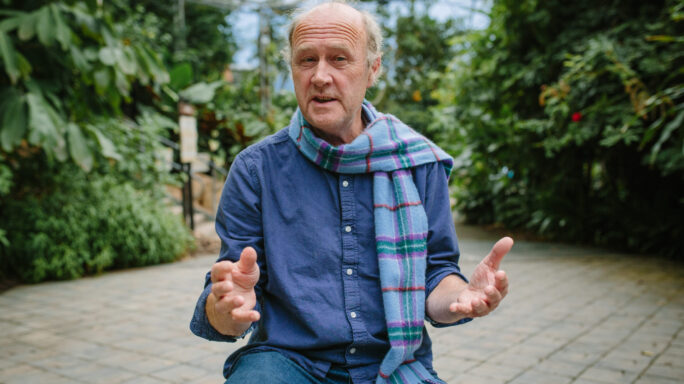Season 3: Building business resilience
Putting a focus on carbon

Tackling sustainability and climate issues is always going to be tough. As a business, you’re trying to find your place in resolving global challenges. So deciding where to focus your attention can be daunting. But it is a must.
Finding our focus
At Interface, we’re a flooring manufacturer that is considered a leader in sustainability. When we started our sustainability journey in the 1990s we worked to identify seven key areas where we felt we could drive or influence change: eliminating waste, benign emissions, renewable energy, closing the loop, resource efficient transportation, sensitising stakeholders, and redesigning commerce. Quickly, we discovered that carbon emissions were at the heart of most of these. From then, until today, reducing our carbon footprint has been a key focus and priority for us.
Where you prioritise with your business will depend on what you do, where you are and perhaps national legislation, but for most, carbon and circularity represent a sensible place to start.
Climate Take Back
We find that, as a floor tile manufacturer, the majority of our environmental impact is in the carbon emissions related to sourcing raw materials for our products, making them and then what happens to them at the end of life. As a result, we have chosen in our Climate Take Back mission to focus on carbon.
My advice is always to establish where your major impact or ability to influence is and focus your attention there.
Carbon and a focus toward net zero
The science and our lived experience is clear. The planet is warming at an alarming rate and reducing humanity’s carbon footprint is the most essential step we can take.
Under the Paris Agreement the global aim is to take action to limit global temperature rise to below 2°C above pre-industrial levels, and ideally pursue efforts to limit warming to 1.5°C to achieve net zero carbon emissions by mid-century. Net zero carbon emissions means that total emissions released are equal to or less than the emissions removed by the environment.
For any business this means contributing to this global aim by finding ways to reduce your carbon emissions and a stepping-stone to this involves becoming carbon neutral.
Jon Khoo
Carbon Neutral Enterprise
For me, if you can become a carbon neutral company or offer a carbon neutral product today to contribute to this, why wouldn’t you?
Renewable energy
A key step for any business to achieve this will be to ensure that it seeks to switch to 100% renewable energy. By becoming more energy efficient and embracing renewable forms of energy such as wind, solar and geothermal forms of power we can turn off our dependence on fossil fuels. Often it is our own engineers that recognise the inefficiencies and suggest ways to remedy or innovate.
We have also been helped by being part of the RE100 movement – a global initiative bringing together hundreds of large and ambitious businesses committed to 100% renewable electricity ad operating in over 170 countries.
At a more local level look to see whether there are industry groups or cross-sector initiatives on renewable energy in your location as this is an area where everyone is facing similar challenges. For example, the Islington Sustainability Network in London, UK brings together SMEs, the local council and the architecture design community to provide tools and a platform to share experiences. Or Drawdown Georgia, USA connects varied businesses on electricity, buildings, food and agriculture, land-based carbon sinks and transport.
Science Based Targets
In 2021, we also had our Science Based Target (SBT) ratified. The Science Based Targets Initiative is a collaboration between CDP, the UN Global Compact, the World Resources Institute and the World Wide Fund for Nature that was established to help companies set us emission reduction targets in line with current climate science. Over 3,000 companies have joined the initiative since 2015 with Science Based Targets emerging as a great way for investors, procurement teams and even employees to compare the carbon targets of different enterprise in a way that compares apples to apples.
What a Science Based Target means for us
For our business, achieving our SBT requires us to demonstrate reductions without the use of carbon offsets. We have been able to focus our efforts on reductions beyond our current carbon neutral status. This includes incorporating carbon negative materials into our products and considering how our factories could act more like forests, and positively impact the local environment and community.
By 2030, under our SBT we are committed to reducing our Scope 1 and 2 (direct and indirect energy emissions) by 50% and then also to reduce our Scope 3 supply chain emissions (purchased goods and services) by 50% in the same period.
For SME’s there is a specific streamlined process (with over 500 employees) to sign-up for an SBT, or an alternative commitment through the SME Climate Hub for smaller SMEs.
Starting with carbon
So, considering the carbon footprint of your offices, your services and/or products is crucial for any company tackling sustainability seriously. It’s measurable and manageable and probably the most sensible place to start.





Leave a comment